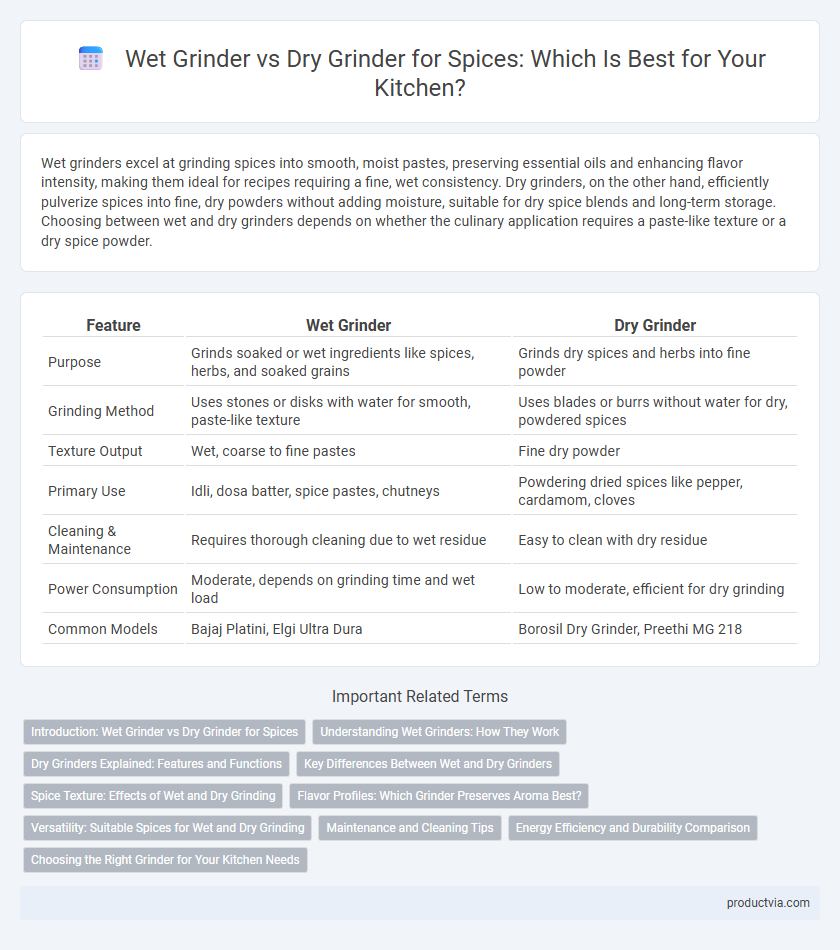Wet grinders excel at grinding spices into smooth, moist pastes, preserving essential oils and enhancing flavor intensity, making them ideal for recipes requiring a fine, wet consistency. Dry grinders, on the other hand, efficiently pulverize spices into fine, dry powders without adding moisture, suitable for dry spice blends and long-term storage. Choosing between wet and dry grinders depends on whether the culinary application requires a paste-like texture or a dry spice powder.
Table of Comparison
| Feature | Wet Grinder | Dry Grinder |
|---|---|---|
| Purpose | Grinds soaked or wet ingredients like spices, herbs, and soaked grains | Grinds dry spices and herbs into fine powder |
| Grinding Method | Uses stones or disks with water for smooth, paste-like texture | Uses blades or burrs without water for dry, powdered spices |
| Texture Output | Wet, coarse to fine pastes | Fine dry powder |
| Primary Use | Idli, dosa batter, spice pastes, chutneys | Powdering dried spices like pepper, cardamom, cloves |
| Cleaning & Maintenance | Requires thorough cleaning due to wet residue | Easy to clean with dry residue |
| Power Consumption | Moderate, depends on grinding time and wet load | Low to moderate, efficient for dry grinding |
| Common Models | Bajaj Platini, Elgi Ultra Dura | Borosil Dry Grinder, Preethi MG 218 |
Introduction: Wet Grinder vs Dry Grinder for Spices
Wet grinders use water to cool spices during grinding, preserving essential oils and resulting in a finer, aromatic powder ideal for sensitive spices like cardamom and cloves. Dry grinders operate without moisture, making them suitable for tough spices like peppercorns and dried red chilies, producing a coarser texture without altering the spice's natural flavor. Selecting between wet and dry grinders depends on the spice type and desired consistency for optimal culinary use.
Understanding Wet Grinders: How They Work
Wet grinders use water or other liquids to grind spices, creating a smooth and consistent paste by preventing heat buildup during the grinding process. The stone grinding mechanism in wet grinders preserves essential oils and flavors in spices, enhancing their aroma and taste. These grinders are ideal for preparing spice pastes and chutneys, maintaining the natural moisture and texture of ingredients.
Dry Grinders Explained: Features and Functions
Dry grinders for spices are designed to efficiently pulverize whole spices into fine powder without the need for water, preserving the natural oils and flavor. These grinders typically feature high-speed blades or burrs made of stainless steel, ensuring durability and consistent texture. Compact and easy to clean, dry grinders offer a quick and convenient solution for preparing spice blends, enhancing culinary precision.
Key Differences Between Wet and Dry Grinders
Wet grinders use water or other liquids to grind spices into pastes, preserving aroma and texture, while dry grinders crush spices into fine powders without moisture, ideal for long-term storage. Wet grinders typically feature stone or stainless steel drums that retain essential oils, whereas dry grinders use blades or burrs designed for coarse to fine grinding without altering spice moisture content. The choice depends on desired spice form and culinary application, with wet grinders preferred for fresh, moist mixtures and dry grinders favored for dry spice blends and powders.
Spice Texture: Effects of Wet and Dry Grinding
Wet grinders produce a finer, more uniform spice texture by using water or oil to reduce heat and prevent spice degradation during grinding. Dry grinders generate coarser particles with a more abrasive texture, ideal for spices needing a robust, crunchy profile. The choice between wet and dry grinding significantly impacts the spice's flavor release and shelf stability due to differences in moisture content and particle size.
Flavor Profiles: Which Grinder Preserves Aroma Best?
Wet grinders retain the natural oils in spices, enhancing and preserving their aroma and flavor profiles more effectively than dry grinders. Dry grinders generate higher heat during processing, which can cause volatile oils to evaporate, leading to a loss of aroma and a muted flavor. For optimal spice flavor and fragrance preservation, wet grinding is preferred due to its gentle, cooler grinding process.
Versatility: Suitable Spices for Wet and Dry Grinding
Wet grinders excel in grinding spices like turmeric, garlic, and ginger to a smooth paste, enhancing flavor release and aroma. Dry grinders are ideal for grinding hard, dry spices such as black pepper, cumin, and coriander into fine powders without moisture interference. Choosing between wet and dry grinders depends on the desired texture and intended culinary use, ensuring maximum versatility for diverse spice preparations.
Maintenance and Cleaning Tips
Wet grinders used for spices require thorough cleaning immediately after use to prevent residue buildup and mold growth, involving disassembling parts and washing with warm soapy water. Dry grinders have simpler maintenance, needing only occasional brushing to remove fine spice dust and wiping with a dry cloth to avoid moisture-related damage. Regular maintenance extends the grinder's lifespan, ensuring optimal grinding performance and hygiene.
Energy Efficiency and Durability Comparison
Wet grinders for spices consume more energy due to the water cooling system but offer greater durability because of the robust stone grinding mechanism that minimizes wear and tear. Dry grinders use less electricity, making them more energy-efficient; however, their blades often dull faster, reducing long-term durability. Choosing between wet and dry grinders depends on balancing energy consumption with maintenance frequency and tool longevity.
Choosing the Right Grinder for Your Kitchen Needs
Wet grinders use water or other liquids to grind spices into a paste, preserving oils and enhancing flavor, making them ideal for moist spice blends and chutneys. Dry grinders crush spices into fine powders without moisture, perfect for dry spice mixes and longer shelf life. Selecting the right grinder depends on the type of spices used and the desired texture, ensuring optimal cooking results and kitchen efficiency.
Wet grinder vs dry grinder for spices Infographic

 productvia.com
productvia.com